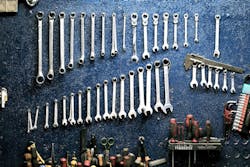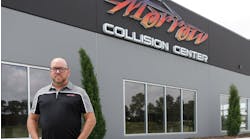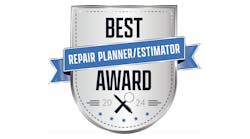SHOP STATS: The Ding Guy Location: Colorado Springs, Colo. Operator: James Bishop Staff Size: 7 at paintless dent repair facility/ 6 at the body shop Shop Size: 7,000 sq ft for paintless dent repair facility/ 5,000 sq ft for body shop; Annual Revenue:$1.8 million to $2.4 million Monthly Car Count:42
Back in the early 1990s, James Bishop says paintless dent repair was considered magic—voodoo even—to body shop owners.
When Bishop first opened his paintless dent repair facility, both customers and other shop owners were skeptical of its potential for success. And when he recently opened a separate body shop, even potential employees were wary of the endeavor.
Bishop created The Ding Guy business in the early ‘90s, when only roughly 500 people in the industry dabbled in paintless dent repair. Yet, Bishop was determined to turn his business into a high-profit margin and turn around the “dingman” association, a term from the 1920s that referred to the last person in the assembly lines to check on the shell or frame of cars.
So, Bishop created a brand that could easily be remembered by customers and would be a catchy phone number: 1-800-Ding-Guy.
He grew the business to become a reputable, well established presence in the community, but when he decided to open a separate body shop in 2016, he was astonished to find that many of the connotations surrounding paintless dent repair still existed—and affected his ability to hire quality employees, which he sorely needed.
Overcoming those stereotypes and hiring a solid team would require Bishop to effectively sell the benefits of paintless dent repair work and the opportunities available within that segment.
The Backstory
Bishop started in the paintless dent repair market because Colorado Springs, Colo., was part of the hail storm region of the U.S. and a lot of repair jobs were purely cosmetic damage, he says.
Along with the entire midwest and south of the U.S., Colorado reaches the top three states in hail damage. The “hail alley” could potentially receive upward of 10 hail storms per year.
From 2013–2015 alone, Colorado had the second-highest number of hail claims in the U.S., according to a May 2016 National Insurance Crime Bureau report.
Bishop realized paintless dent repair could save customers money on cosmetic damage repairs and also help the body shop stay away from investing large amounts of money in structural damage repairs. That paved the way for the success of his paintless dent repair business.
The Problem
In 2016, Bishop decided to open a body shop just three blocks down from the original paintless dent repair—with a unique business plan.
The idea, Bishop says, is that all customers still go through the paintless dent repair location, and if more body work is needed, the vehicle is transferred to the body shop by an employee. In fact, Bishop doesn’t want any customers coming through the body shop—there is no signage, waiting room and a sign reads “do not enter” at the front.
Adding this segment of the business, however, required staffing the shop and getting everyone on board with a plan to save money on parts buying from the PDR process.
Going into the business, he knew paintless dent repair was almost frowned upon and had an extremely negative connotation. He also knew the business received heavy competition from body shops. Overcoming that stereotype and finding quality employees would require him to sell the business and its true value to prospective employees.
The Solution
Bishop left all his administrative staff at his original paintless dent repair shop. At the new body shop, he hired a team of six to do the heavier repairs.
He discovered a team buy-in on paintless dent repair required a unique attitude. The attitude needed to be one that was open-minded and not focused on drama.
All advertising to attract potential hires was conducted online, he says. He posted on social media sites about the environmental impact of the process and also how the process helps with the current “poor quality” aftermarket parts flooding the market.
Information is gathered from Bishop’s own records and from paint representatives about the waste created by refinishing panels and the VOCs saved from applying clear coats, he says.
Next, Bishop would have the potential hire describe a scenario at a previous job in which they had a problem with another employee and how they handled it. If someone answered by describing how they want to work alone for the majority of the week, Bishop would not hire the candidate.
Once the team was hired, Bishop needed to show them how the process could make not only the whole shop annual revenue increase but also produce a larger ticket:
- By doing paintless dent repair, the technician saves on prep time and painting unnecessary panels.
- The shop saves overall on not investing in larger parts that were fixed through the PDR shop. By doing paintless dent repair, the business saves money on a panel that the insurance company would pay to replace. Now, the shop does not need to replace it.
- Bishop says it is standard to paint a panel and not blend paint between panels if it is within 20 inches of the panel’s seam.
- Less of the car needs to go through the paint refinishing process.
- The process can save a customer an entire deductible or at least reduce estimates by roughly $3,000.
- The staff can now see the environmental impact of the process. Bishop says he has saved a 55 gallon drum of paint by simply not scrapping the panels in the tear-down process.
The Aftermath
By restructuring the business plan and getting employees on board with the process, Bishop was able to hire seven body shop employees. Since then, he’s experienced two employees leaving for reasons not pertaining to the process and feels he has a solid team in place to handle PDR work.
In addition to money saved for employees, an ease of communication allows Bishop to advertise a less stressful process. His team uses their cellphones to eliminate some challenges in communication. Since the buildings are three blocks away from each other, the staff mostly communicates via FaceTime or text messages, Bishop says.
The Takeaway
He says he notices a lot of body technicians see this change as inevitable and through education in the benefits, are more interested in learning about The Ding Guy jobs.
Expert Advice: Improve Your PDR Business Plan
—
Chris Brogan, CEO of Owner Media Group, a company that provides resources to grow businesses, shares how to market a paintless dent repair business plan:
1. Get Involved. A business owner first needs to join the conversation in the area they serve. They can do this simply by going to Twitter and searching the name of the town to see what has people talking and participate in the conversation.
“Remember you are a participant at best when you are online,” Brogan says. “No one’s eager to talk to a dent specialist unless they need you.”
2. Check In. The staff needs to open a line of communication with the customer. Throughout the process, check in with the customer and fill them in on where the vehicle is in the repair.
Even if the review is bad, ask for it. This way, you’ll never hide the bad and only show the customers the good on your website.
Brogan says about 70 percent of people will report feeling anxiety about a company’s website, even if they can’t figure out why.
3. Go Digital. Reach out to customers via not only in-person communication, but also online and through video formats. Ask yourself, “What kinds of information would they find helpful beyond what it is you sell?”



